Soil Formation Process: Factors, Analysis, and Alluvial Soils
VerifiedAdded on 2022/10/17
|12
|2723
|9
Report
AI Summary
This report provides a comprehensive overview of soil formation, detailing the processes involved and the factors that influence it. The introduction establishes the significance of soil and its importance in the ecological system, defining it from different scientific perspectives. It then explores the soil profile and the various components that make up soil, emphasizing how these components vary across different regions. The report outlines the four soil formation processes: addition, transformation, translocation, and losses. It further examines the factors affecting soil formation, including living organisms, parent material, topography, time, and climate. The report also defines alluvial soil, its types, and its relationship with climate and weathering in the Fraser Valley. Finally, it discusses the origin and dynamics of various plant nutrients within the soil, highlighting the importance of understanding soil composition for sustainable land management. The report concludes with a summary of the key findings and their implications for soil science.
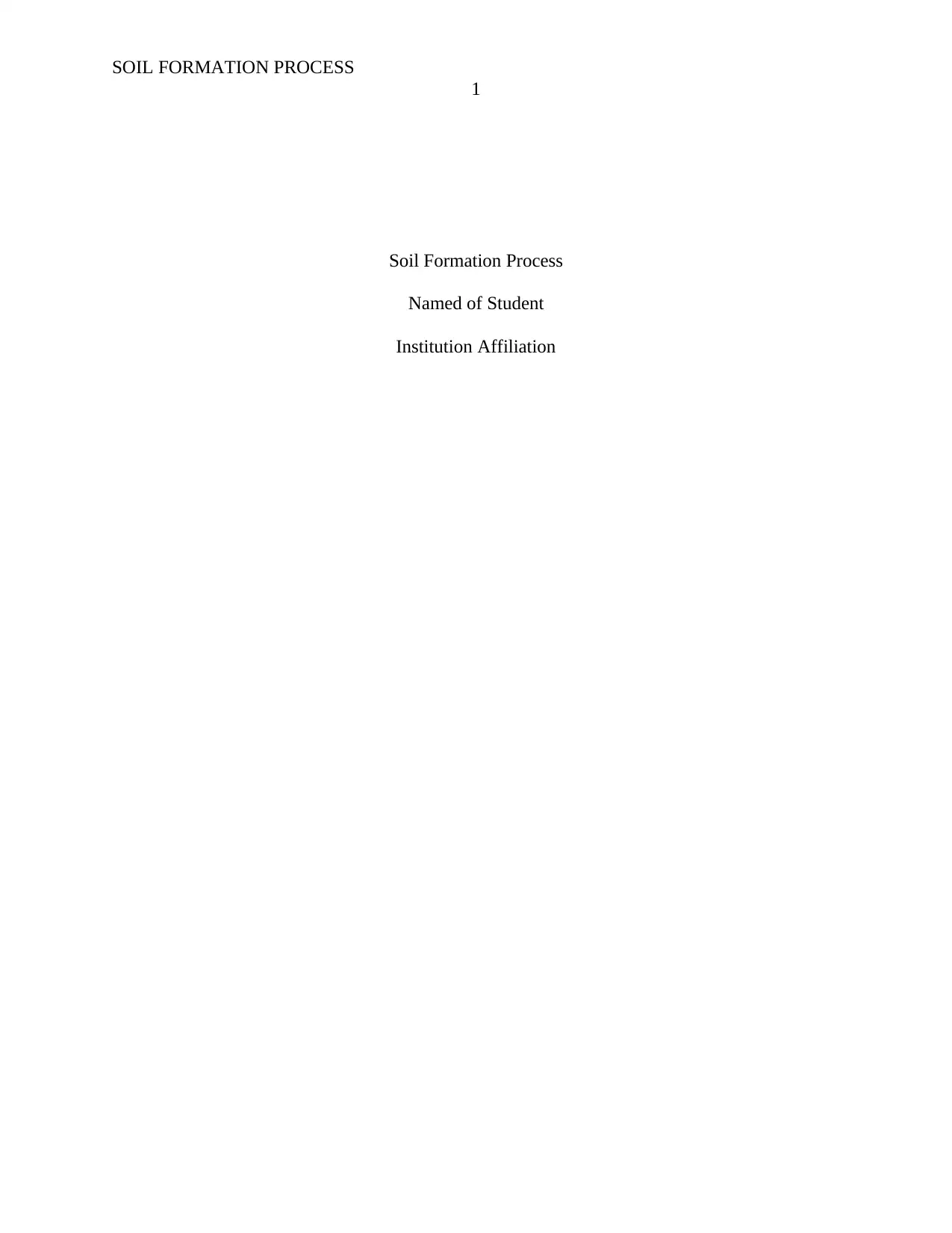
SOIL FORMATION PROCESS
1
Soil Formation Process
Named of Student
Institution Affiliation
1
Soil Formation Process
Named of Student
Institution Affiliation
Paraphrase This Document
Need a fresh take? Get an instant paraphrase of this document with our AI Paraphraser
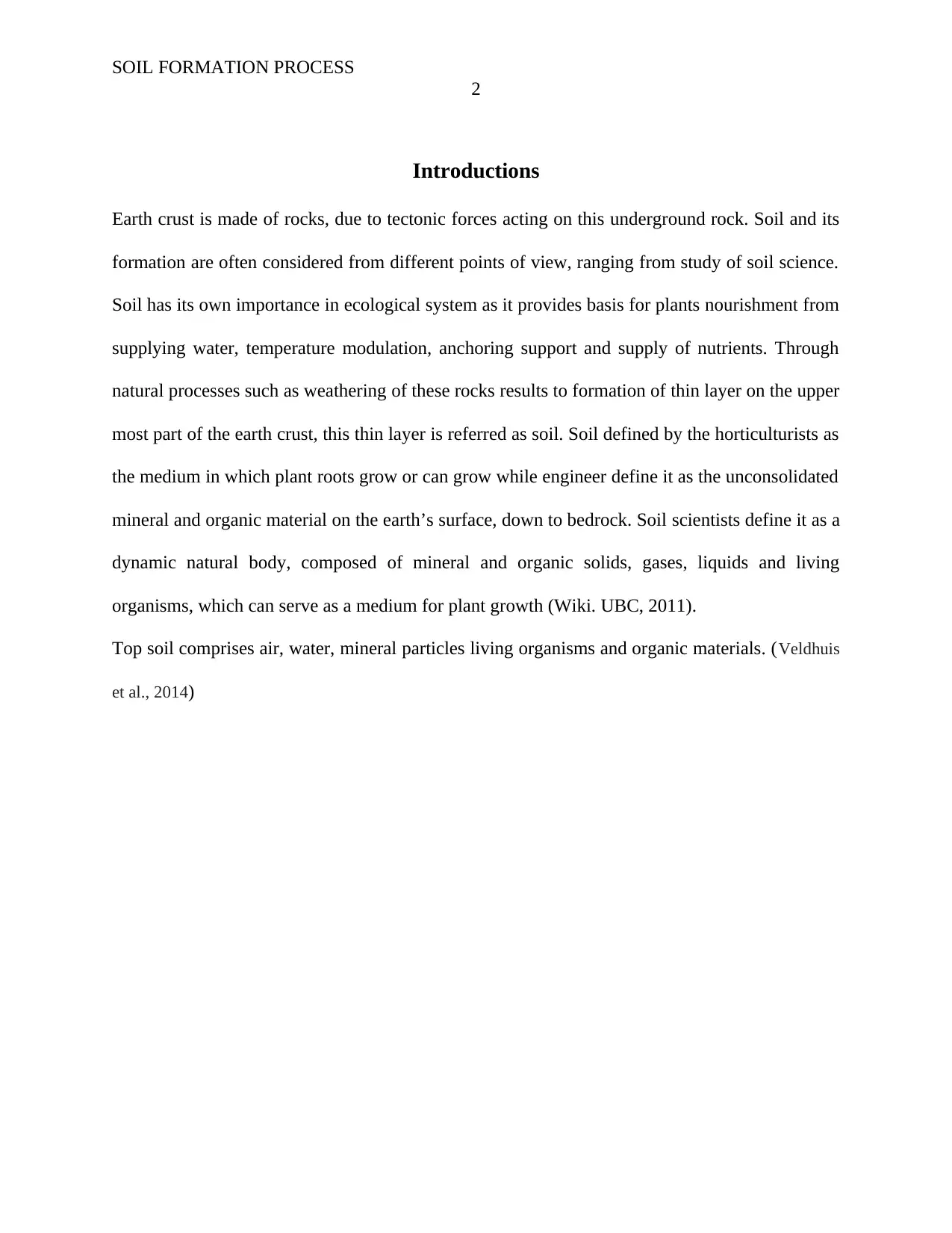
SOIL FORMATION PROCESS
2
Introductions
Earth crust is made of rocks, due to tectonic forces acting on this underground rock. Soil and its
formation are often considered from different points of view, ranging from study of soil science.
Soil has its own importance in ecological system as it provides basis for plants nourishment from
supplying water, temperature modulation, anchoring support and supply of nutrients. Through
natural processes such as weathering of these rocks results to formation of thin layer on the upper
most part of the earth crust, this thin layer is referred as soil. Soil defined by the horticulturists as
the medium in which plant roots grow or can grow while engineer define it as the unconsolidated
mineral and organic material on the earth’s surface, down to bedrock. Soil scientists define it as a
dynamic natural body, composed of mineral and organic solids, gases, liquids and living
organisms, which can serve as a medium for plant growth (Wiki. UBC, 2011).
Top soil comprises air, water, mineral particles living organisms and organic materials. (Veldhuis
et al., 2014)
2
Introductions
Earth crust is made of rocks, due to tectonic forces acting on this underground rock. Soil and its
formation are often considered from different points of view, ranging from study of soil science.
Soil has its own importance in ecological system as it provides basis for plants nourishment from
supplying water, temperature modulation, anchoring support and supply of nutrients. Through
natural processes such as weathering of these rocks results to formation of thin layer on the upper
most part of the earth crust, this thin layer is referred as soil. Soil defined by the horticulturists as
the medium in which plant roots grow or can grow while engineer define it as the unconsolidated
mineral and organic material on the earth’s surface, down to bedrock. Soil scientists define it as a
dynamic natural body, composed of mineral and organic solids, gases, liquids and living
organisms, which can serve as a medium for plant growth (Wiki. UBC, 2011).
Top soil comprises air, water, mineral particles living organisms and organic materials. (Veldhuis
et al., 2014)
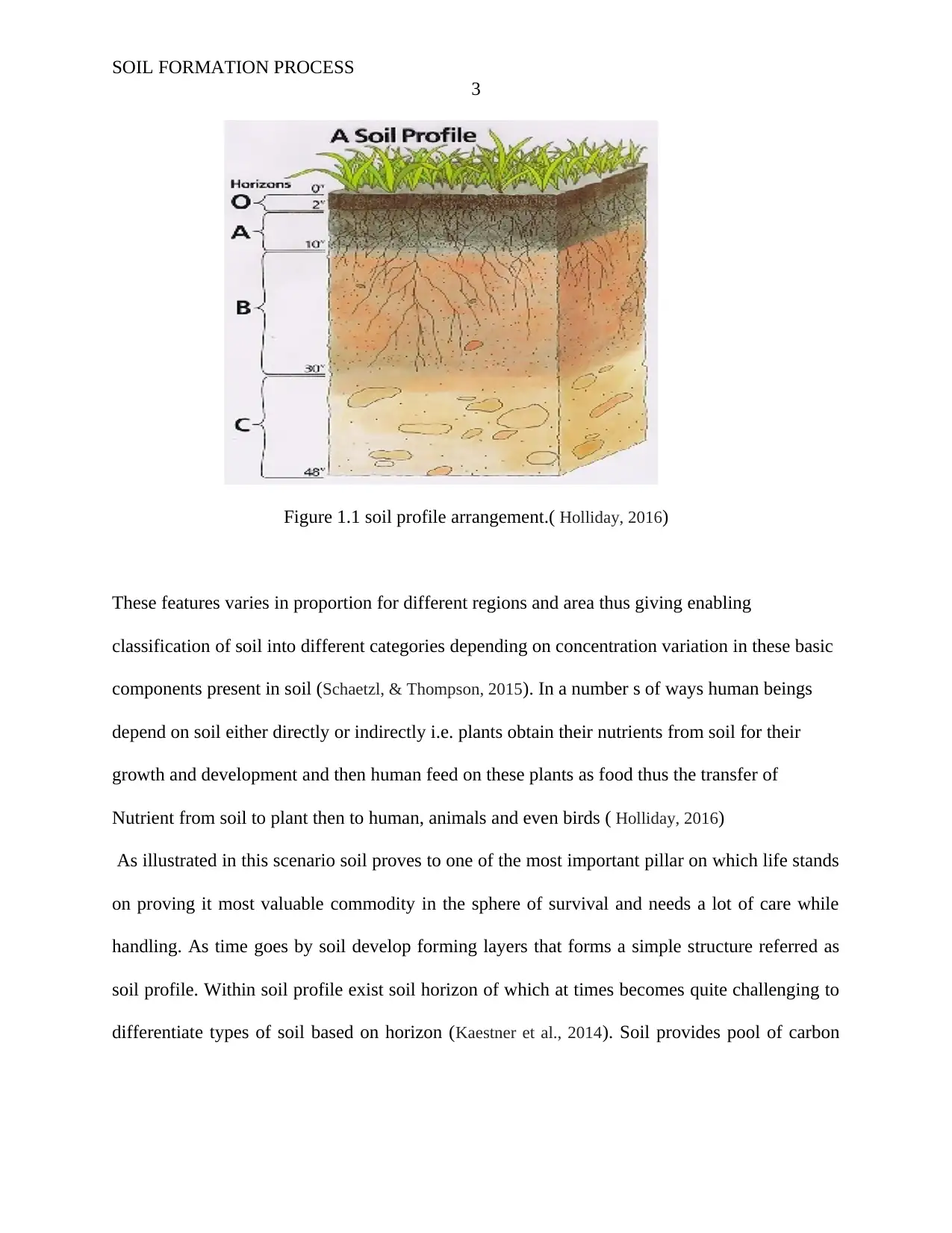
SOIL FORMATION PROCESS
3
Figure 1.1 soil profile arrangement.( Holliday, 2016)
These features varies in proportion for different regions and area thus giving enabling
classification of soil into different categories depending on concentration variation in these basic
components present in soil (Schaetzl, & Thompson, 2015). In a number s of ways human beings
depend on soil either directly or indirectly i.e. plants obtain their nutrients from soil for their
growth and development and then human feed on these plants as food thus the transfer of
Nutrient from soil to plant then to human, animals and even birds ( Holliday, 2016)
As illustrated in this scenario soil proves to one of the most important pillar on which life stands
on proving it most valuable commodity in the sphere of survival and needs a lot of care while
handling. As time goes by soil develop forming layers that forms a simple structure referred as
soil profile. Within soil profile exist soil horizon of which at times becomes quite challenging to
differentiate types of soil based on horizon (Kaestner et al., 2014). Soil provides pool of carbon
3
Figure 1.1 soil profile arrangement.( Holliday, 2016)
These features varies in proportion for different regions and area thus giving enabling
classification of soil into different categories depending on concentration variation in these basic
components present in soil (Schaetzl, & Thompson, 2015). In a number s of ways human beings
depend on soil either directly or indirectly i.e. plants obtain their nutrients from soil for their
growth and development and then human feed on these plants as food thus the transfer of
Nutrient from soil to plant then to human, animals and even birds ( Holliday, 2016)
As illustrated in this scenario soil proves to one of the most important pillar on which life stands
on proving it most valuable commodity in the sphere of survival and needs a lot of care while
handling. As time goes by soil develop forming layers that forms a simple structure referred as
soil profile. Within soil profile exist soil horizon of which at times becomes quite challenging to
differentiate types of soil based on horizon (Kaestner et al., 2014). Soil provides pool of carbon
⊘ This is a preview!⊘
Do you want full access?
Subscribe today to unlock all pages.

Trusted by 1+ million students worldwide
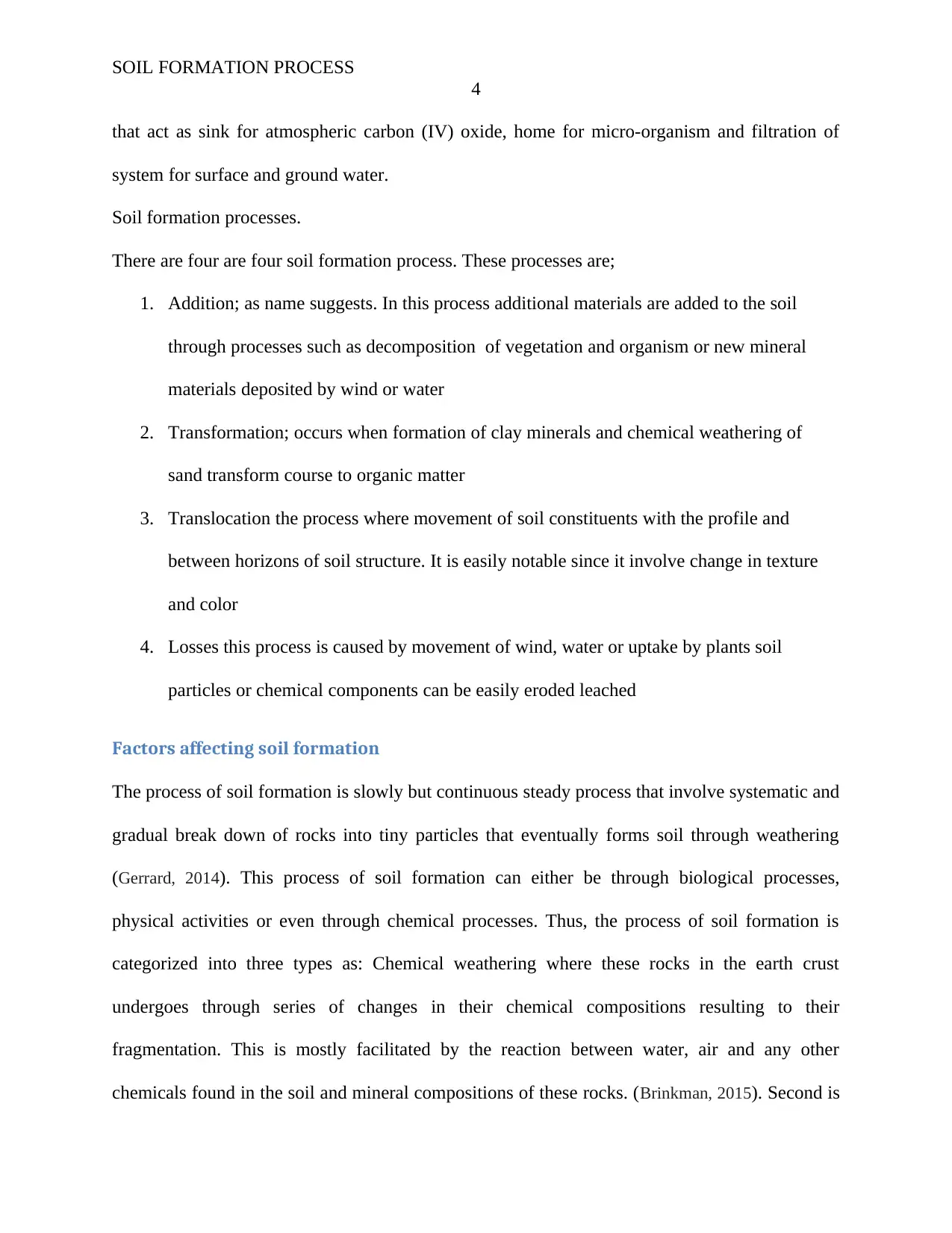
SOIL FORMATION PROCESS
4
that act as sink for atmospheric carbon (IV) oxide, home for micro-organism and filtration of
system for surface and ground water.
Soil formation processes.
There are four are four soil formation process. These processes are;
1. Addition; as name suggests. In this process additional materials are added to the soil
through processes such as decomposition of vegetation and organism or new mineral
materials deposited by wind or water
2. Transformation; occurs when formation of clay minerals and chemical weathering of
sand transform course to organic matter
3. Translocation the process where movement of soil constituents with the profile and
between horizons of soil structure. It is easily notable since it involve change in texture
and color
4. Losses this process is caused by movement of wind, water or uptake by plants soil
particles or chemical components can be easily eroded leached
Factors affecting soil formation
The process of soil formation is slowly but continuous steady process that involve systematic and
gradual break down of rocks into tiny particles that eventually forms soil through weathering
(Gerrard, 2014). This process of soil formation can either be through biological processes,
physical activities or even through chemical processes. Thus, the process of soil formation is
categorized into three types as: Chemical weathering where these rocks in the earth crust
undergoes through series of changes in their chemical compositions resulting to their
fragmentation. This is mostly facilitated by the reaction between water, air and any other
chemicals found in the soil and mineral compositions of these rocks. (Brinkman, 2015). Second is
4
that act as sink for atmospheric carbon (IV) oxide, home for micro-organism and filtration of
system for surface and ground water.
Soil formation processes.
There are four are four soil formation process. These processes are;
1. Addition; as name suggests. In this process additional materials are added to the soil
through processes such as decomposition of vegetation and organism or new mineral
materials deposited by wind or water
2. Transformation; occurs when formation of clay minerals and chemical weathering of
sand transform course to organic matter
3. Translocation the process where movement of soil constituents with the profile and
between horizons of soil structure. It is easily notable since it involve change in texture
and color
4. Losses this process is caused by movement of wind, water or uptake by plants soil
particles or chemical components can be easily eroded leached
Factors affecting soil formation
The process of soil formation is slowly but continuous steady process that involve systematic and
gradual break down of rocks into tiny particles that eventually forms soil through weathering
(Gerrard, 2014). This process of soil formation can either be through biological processes,
physical activities or even through chemical processes. Thus, the process of soil formation is
categorized into three types as: Chemical weathering where these rocks in the earth crust
undergoes through series of changes in their chemical compositions resulting to their
fragmentation. This is mostly facilitated by the reaction between water, air and any other
chemicals found in the soil and mineral compositions of these rocks. (Brinkman, 2015). Second is
Paraphrase This Document
Need a fresh take? Get an instant paraphrase of this document with our AI Paraphraser
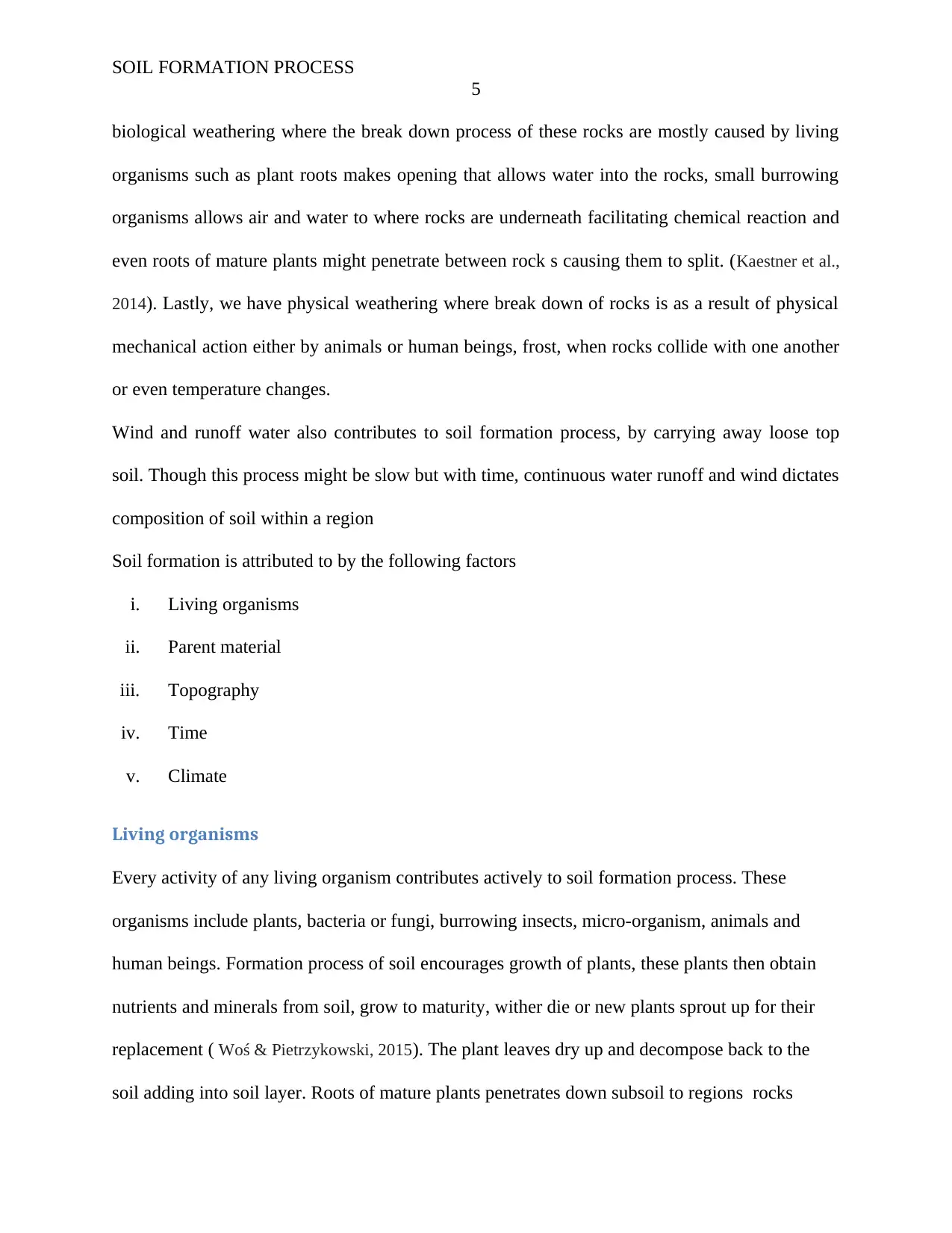
SOIL FORMATION PROCESS
5
biological weathering where the break down process of these rocks are mostly caused by living
organisms such as plant roots makes opening that allows water into the rocks, small burrowing
organisms allows air and water to where rocks are underneath facilitating chemical reaction and
even roots of mature plants might penetrate between rock s causing them to split. (Kaestner et al.,
2014). Lastly, we have physical weathering where break down of rocks is as a result of physical
mechanical action either by animals or human beings, frost, when rocks collide with one another
or even temperature changes.
Wind and runoff water also contributes to soil formation process, by carrying away loose top
soil. Though this process might be slow but with time, continuous water runoff and wind dictates
composition of soil within a region
Soil formation is attributed to by the following factors
i. Living organisms
ii. Parent material
iii. Topography
iv. Time
v. Climate
Living organisms
Every activity of any living organism contributes actively to soil formation process. These
organisms include plants, bacteria or fungi, burrowing insects, micro-organism, animals and
human beings. Formation process of soil encourages growth of plants, these plants then obtain
nutrients and minerals from soil, grow to maturity, wither die or new plants sprout up for their
replacement ( Woś & Pietrzykowski, 2015). The plant leaves dry up and decompose back to the
soil adding into soil layer. Roots of mature plants penetrates down subsoil to regions rocks
5
biological weathering where the break down process of these rocks are mostly caused by living
organisms such as plant roots makes opening that allows water into the rocks, small burrowing
organisms allows air and water to where rocks are underneath facilitating chemical reaction and
even roots of mature plants might penetrate between rock s causing them to split. (Kaestner et al.,
2014). Lastly, we have physical weathering where break down of rocks is as a result of physical
mechanical action either by animals or human beings, frost, when rocks collide with one another
or even temperature changes.
Wind and runoff water also contributes to soil formation process, by carrying away loose top
soil. Though this process might be slow but with time, continuous water runoff and wind dictates
composition of soil within a region
Soil formation is attributed to by the following factors
i. Living organisms
ii. Parent material
iii. Topography
iv. Time
v. Climate
Living organisms
Every activity of any living organism contributes actively to soil formation process. These
organisms include plants, bacteria or fungi, burrowing insects, micro-organism, animals and
human beings. Formation process of soil encourages growth of plants, these plants then obtain
nutrients and minerals from soil, grow to maturity, wither die or new plants sprout up for their
replacement ( Woś & Pietrzykowski, 2015). The plant leaves dry up and decompose back to the
soil adding into soil layer. Roots of mature plants penetrates down subsoil to regions rocks
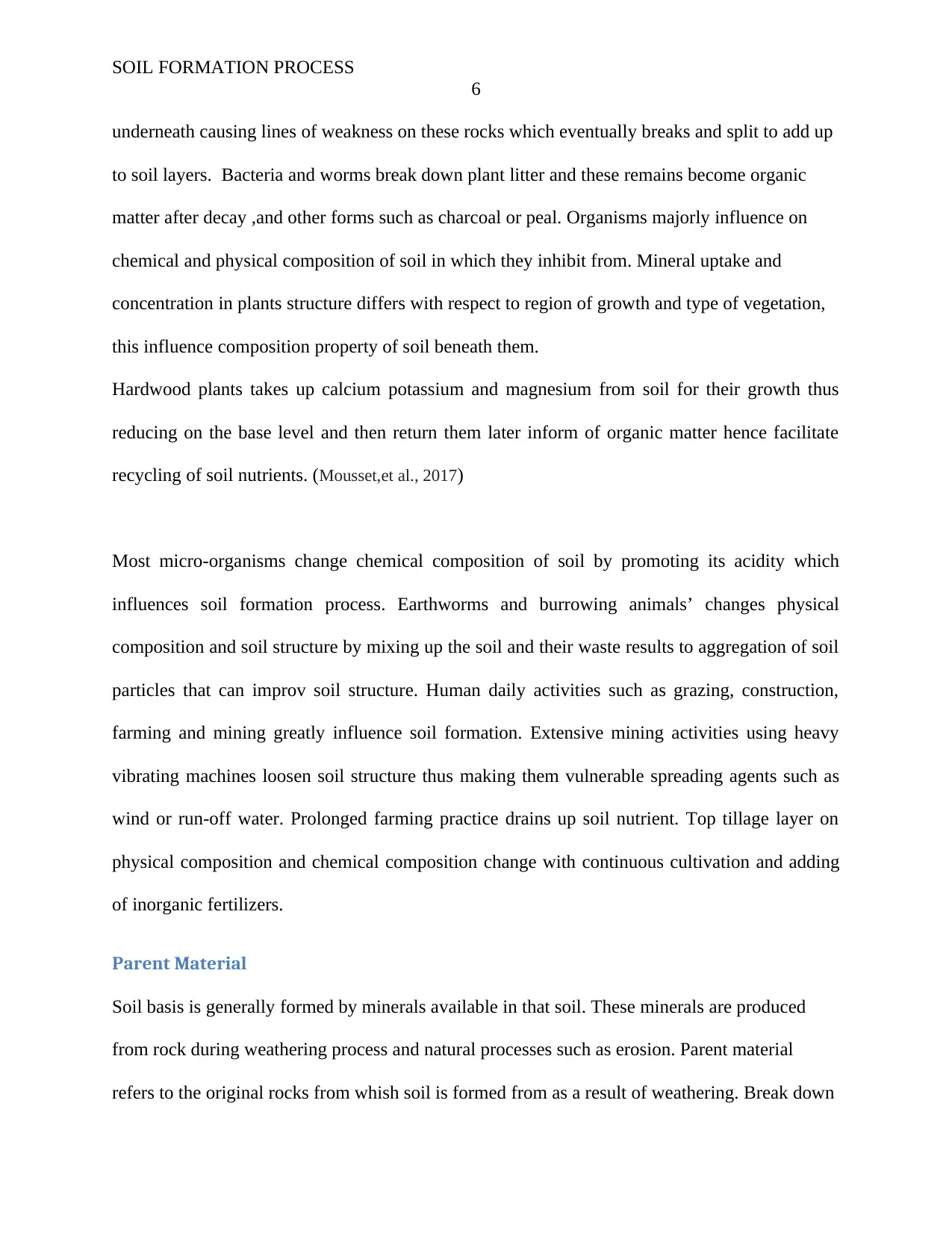
SOIL FORMATION PROCESS
6
underneath causing lines of weakness on these rocks which eventually breaks and split to add up
to soil layers. Bacteria and worms break down plant litter and these remains become organic
matter after decay ,and other forms such as charcoal or peal. Organisms majorly influence on
chemical and physical composition of soil in which they inhibit from. Mineral uptake and
concentration in plants structure differs with respect to region of growth and type of vegetation,
this influence composition property of soil beneath them.
Hardwood plants takes up calcium potassium and magnesium from soil for their growth thus
reducing on the base level and then return them later inform of organic matter hence facilitate
recycling of soil nutrients. (Mousset,et al., 2017)
Most micro-organisms change chemical composition of soil by promoting its acidity which
influences soil formation process. Earthworms and burrowing animals’ changes physical
composition and soil structure by mixing up the soil and their waste results to aggregation of soil
particles that can improv soil structure. Human daily activities such as grazing, construction,
farming and mining greatly influence soil formation. Extensive mining activities using heavy
vibrating machines loosen soil structure thus making them vulnerable spreading agents such as
wind or run-off water. Prolonged farming practice drains up soil nutrient. Top tillage layer on
physical composition and chemical composition change with continuous cultivation and adding
of inorganic fertilizers.
Parent Material
Soil basis is generally formed by minerals available in that soil. These minerals are produced
from rock during weathering process and natural processes such as erosion. Parent material
refers to the original rocks from whish soil is formed from as a result of weathering. Break down
6
underneath causing lines of weakness on these rocks which eventually breaks and split to add up
to soil layers. Bacteria and worms break down plant litter and these remains become organic
matter after decay ,and other forms such as charcoal or peal. Organisms majorly influence on
chemical and physical composition of soil in which they inhibit from. Mineral uptake and
concentration in plants structure differs with respect to region of growth and type of vegetation,
this influence composition property of soil beneath them.
Hardwood plants takes up calcium potassium and magnesium from soil for their growth thus
reducing on the base level and then return them later inform of organic matter hence facilitate
recycling of soil nutrients. (Mousset,et al., 2017)
Most micro-organisms change chemical composition of soil by promoting its acidity which
influences soil formation process. Earthworms and burrowing animals’ changes physical
composition and soil structure by mixing up the soil and their waste results to aggregation of soil
particles that can improv soil structure. Human daily activities such as grazing, construction,
farming and mining greatly influence soil formation. Extensive mining activities using heavy
vibrating machines loosen soil structure thus making them vulnerable spreading agents such as
wind or run-off water. Prolonged farming practice drains up soil nutrient. Top tillage layer on
physical composition and chemical composition change with continuous cultivation and adding
of inorganic fertilizers.
Parent Material
Soil basis is generally formed by minerals available in that soil. These minerals are produced
from rock during weathering process and natural processes such as erosion. Parent material
refers to the original rocks from whish soil is formed from as a result of weathering. Break down
⊘ This is a preview!⊘
Do you want full access?
Subscribe today to unlock all pages.

Trusted by 1+ million students worldwide
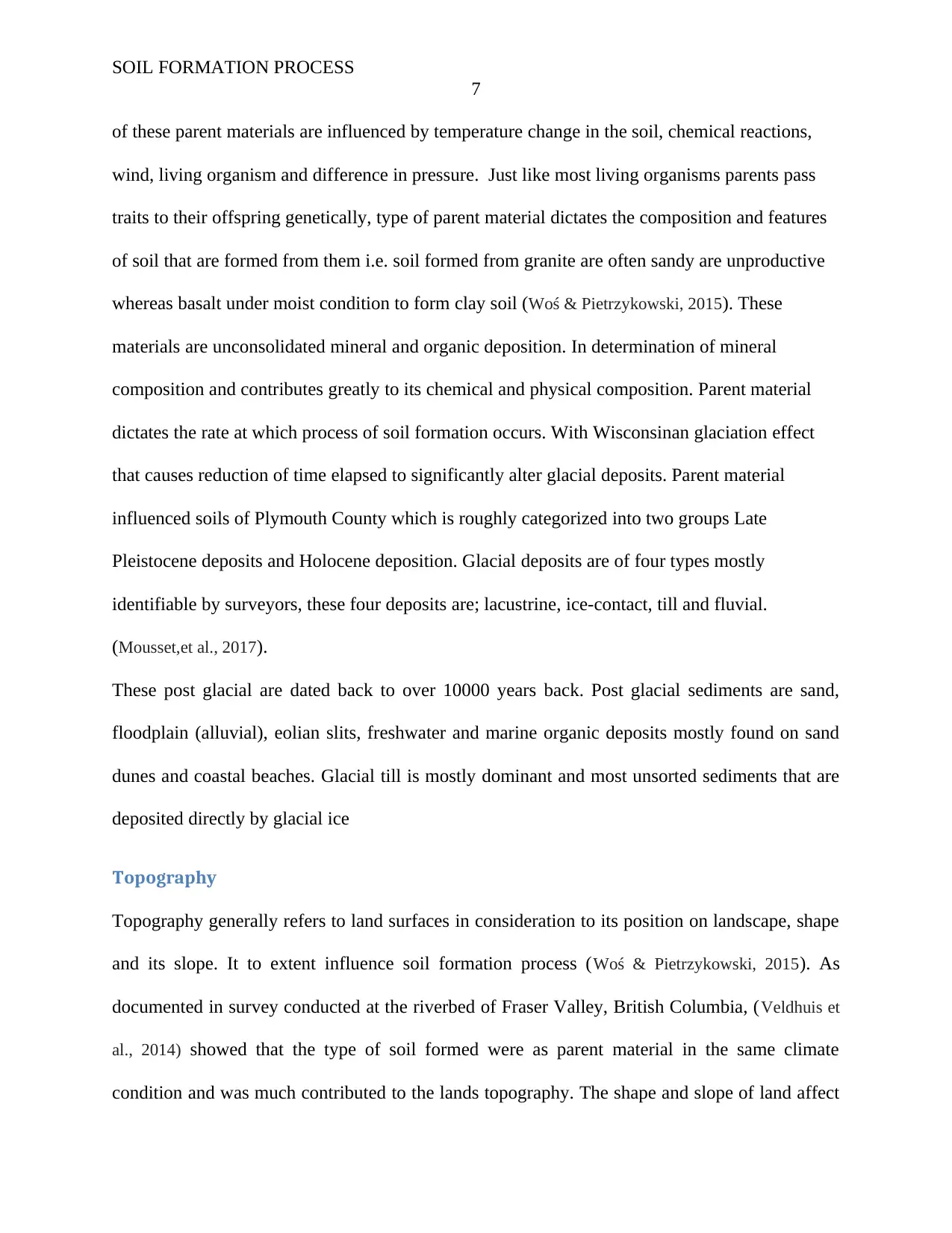
SOIL FORMATION PROCESS
7
of these parent materials are influenced by temperature change in the soil, chemical reactions,
wind, living organism and difference in pressure. Just like most living organisms parents pass
traits to their offspring genetically, type of parent material dictates the composition and features
of soil that are formed from them i.e. soil formed from granite are often sandy are unproductive
whereas basalt under moist condition to form clay soil (Woś & Pietrzykowski, 2015). These
materials are unconsolidated mineral and organic deposition. In determination of mineral
composition and contributes greatly to its chemical and physical composition. Parent material
dictates the rate at which process of soil formation occurs. With Wisconsinan glaciation effect
that causes reduction of time elapsed to significantly alter glacial deposits. Parent material
influenced soils of Plymouth County which is roughly categorized into two groups Late
Pleistocene deposits and Holocene deposition. Glacial deposits are of four types mostly
identifiable by surveyors, these four deposits are; lacustrine, ice-contact, till and fluvial.
(Mousset,et al., 2017).
These post glacial are dated back to over 10000 years back. Post glacial sediments are sand,
floodplain (alluvial), eolian slits, freshwater and marine organic deposits mostly found on sand
dunes and coastal beaches. Glacial till is mostly dominant and most unsorted sediments that are
deposited directly by glacial ice
Topography
Topography generally refers to land surfaces in consideration to its position on landscape, shape
and its slope. It to extent influence soil formation process (Woś & Pietrzykowski, 2015). As
documented in survey conducted at the riverbed of Fraser Valley, British Columbia, (Veldhuis et
al., 2014) showed that the type of soil formed were as parent material in the same climate
condition and was much contributed to the lands topography. The shape and slope of land affect
7
of these parent materials are influenced by temperature change in the soil, chemical reactions,
wind, living organism and difference in pressure. Just like most living organisms parents pass
traits to their offspring genetically, type of parent material dictates the composition and features
of soil that are formed from them i.e. soil formed from granite are often sandy are unproductive
whereas basalt under moist condition to form clay soil (Woś & Pietrzykowski, 2015). These
materials are unconsolidated mineral and organic deposition. In determination of mineral
composition and contributes greatly to its chemical and physical composition. Parent material
dictates the rate at which process of soil formation occurs. With Wisconsinan glaciation effect
that causes reduction of time elapsed to significantly alter glacial deposits. Parent material
influenced soils of Plymouth County which is roughly categorized into two groups Late
Pleistocene deposits and Holocene deposition. Glacial deposits are of four types mostly
identifiable by surveyors, these four deposits are; lacustrine, ice-contact, till and fluvial.
(Mousset,et al., 2017).
These post glacial are dated back to over 10000 years back. Post glacial sediments are sand,
floodplain (alluvial), eolian slits, freshwater and marine organic deposits mostly found on sand
dunes and coastal beaches. Glacial till is mostly dominant and most unsorted sediments that are
deposited directly by glacial ice
Topography
Topography generally refers to land surfaces in consideration to its position on landscape, shape
and its slope. It to extent influence soil formation process (Woś & Pietrzykowski, 2015). As
documented in survey conducted at the riverbed of Fraser Valley, British Columbia, (Veldhuis et
al., 2014) showed that the type of soil formed were as parent material in the same climate
condition and was much contributed to the lands topography. The shape and slope of land affect
Paraphrase This Document
Need a fresh take? Get an instant paraphrase of this document with our AI Paraphraser
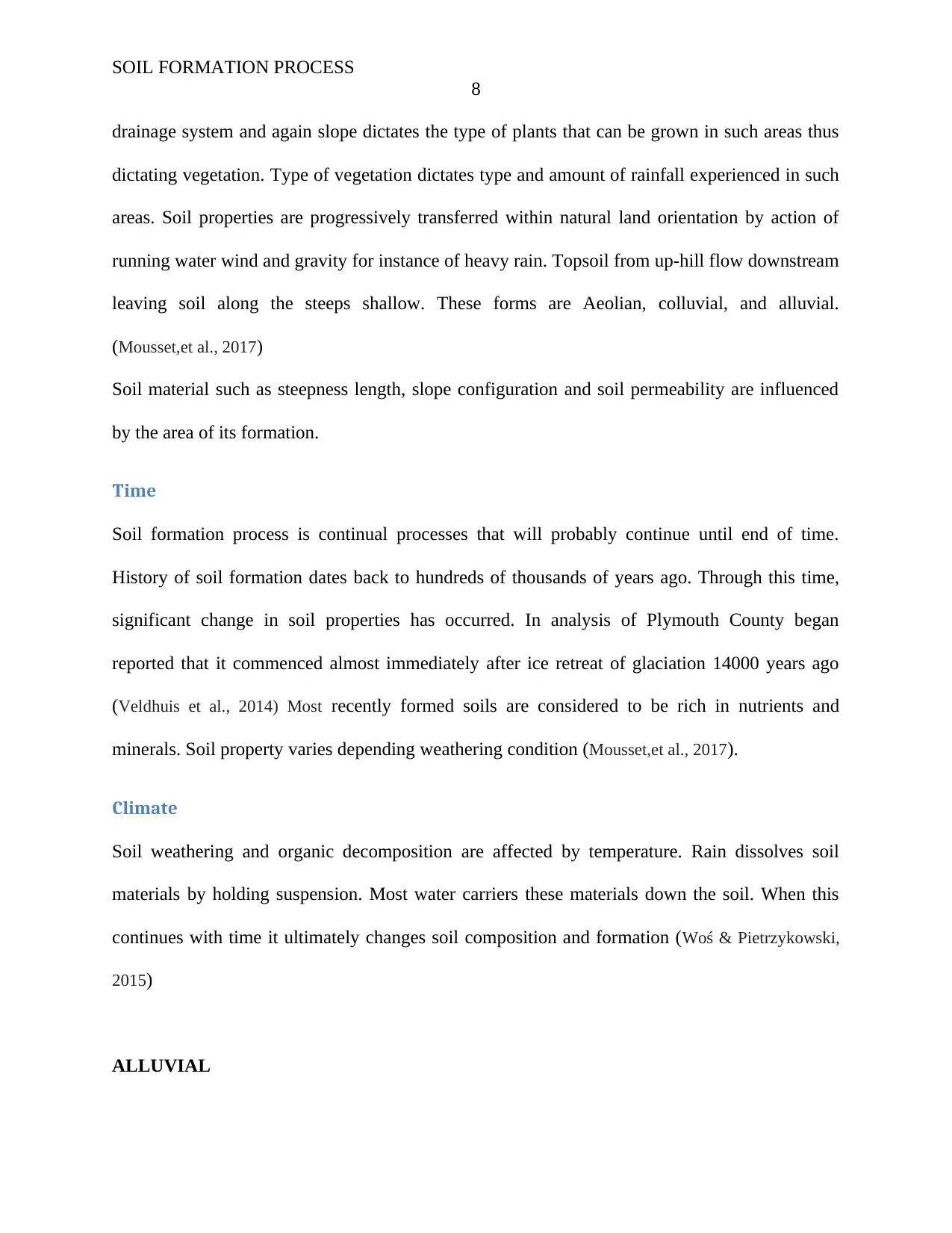
SOIL FORMATION PROCESS
8
drainage system and again slope dictates the type of plants that can be grown in such areas thus
dictating vegetation. Type of vegetation dictates type and amount of rainfall experienced in such
areas. Soil properties are progressively transferred within natural land orientation by action of
running water wind and gravity for instance of heavy rain. Topsoil from up-hill flow downstream
leaving soil along the steeps shallow. These forms are Aeolian, colluvial, and alluvial.
(Mousset,et al., 2017)
Soil material such as steepness length, slope configuration and soil permeability are influenced
by the area of its formation.
Time
Soil formation process is continual processes that will probably continue until end of time.
History of soil formation dates back to hundreds of thousands of years ago. Through this time,
significant change in soil properties has occurred. In analysis of Plymouth County began
reported that it commenced almost immediately after ice retreat of glaciation 14000 years ago
(Veldhuis et al., 2014) Most recently formed soils are considered to be rich in nutrients and
minerals. Soil property varies depending weathering condition (Mousset,et al., 2017).
Climate
Soil weathering and organic decomposition are affected by temperature. Rain dissolves soil
materials by holding suspension. Most water carriers these materials down the soil. When this
continues with time it ultimately changes soil composition and formation (Woś & Pietrzykowski,
2015)
ALLUVIAL
8
drainage system and again slope dictates the type of plants that can be grown in such areas thus
dictating vegetation. Type of vegetation dictates type and amount of rainfall experienced in such
areas. Soil properties are progressively transferred within natural land orientation by action of
running water wind and gravity for instance of heavy rain. Topsoil from up-hill flow downstream
leaving soil along the steeps shallow. These forms are Aeolian, colluvial, and alluvial.
(Mousset,et al., 2017)
Soil material such as steepness length, slope configuration and soil permeability are influenced
by the area of its formation.
Time
Soil formation process is continual processes that will probably continue until end of time.
History of soil formation dates back to hundreds of thousands of years ago. Through this time,
significant change in soil properties has occurred. In analysis of Plymouth County began
reported that it commenced almost immediately after ice retreat of glaciation 14000 years ago
(Veldhuis et al., 2014) Most recently formed soils are considered to be rich in nutrients and
minerals. Soil property varies depending weathering condition (Mousset,et al., 2017).
Climate
Soil weathering and organic decomposition are affected by temperature. Rain dissolves soil
materials by holding suspension. Most water carriers these materials down the soil. When this
continues with time it ultimately changes soil composition and formation (Woś & Pietrzykowski,
2015)
ALLUVIAL
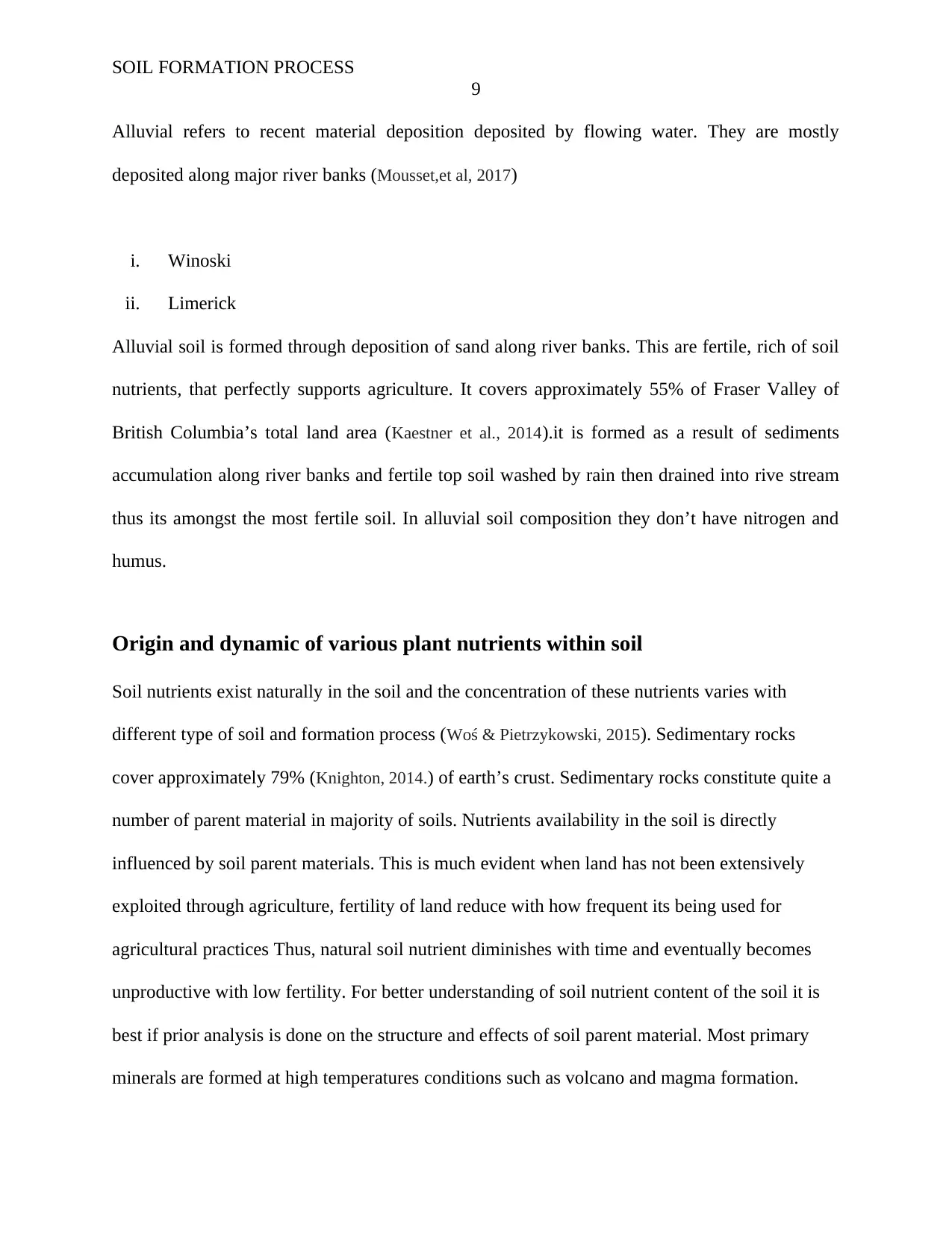
SOIL FORMATION PROCESS
9
Alluvial refers to recent material deposition deposited by flowing water. They are mostly
deposited along major river banks (Mousset,et al, 2017)
i. Winoski
ii. Limerick
Alluvial soil is formed through deposition of sand along river banks. This are fertile, rich of soil
nutrients, that perfectly supports agriculture. It covers approximately 55% of Fraser Valley of
British Columbia’s total land area (Kaestner et al., 2014).it is formed as a result of sediments
accumulation along river banks and fertile top soil washed by rain then drained into rive stream
thus its amongst the most fertile soil. In alluvial soil composition they don’t have nitrogen and
humus.
Origin and dynamic of various plant nutrients within soil
Soil nutrients exist naturally in the soil and the concentration of these nutrients varies with
different type of soil and formation process (Woś & Pietrzykowski, 2015). Sedimentary rocks
cover approximately 79% (Knighton, 2014.) of earth’s crust. Sedimentary rocks constitute quite a
number of parent material in majority of soils. Nutrients availability in the soil is directly
influenced by soil parent materials. This is much evident when land has not been extensively
exploited through agriculture, fertility of land reduce with how frequent its being used for
agricultural practices Thus, natural soil nutrient diminishes with time and eventually becomes
unproductive with low fertility. For better understanding of soil nutrient content of the soil it is
best if prior analysis is done on the structure and effects of soil parent material. Most primary
minerals are formed at high temperatures conditions such as volcano and magma formation.
9
Alluvial refers to recent material deposition deposited by flowing water. They are mostly
deposited along major river banks (Mousset,et al, 2017)
i. Winoski
ii. Limerick
Alluvial soil is formed through deposition of sand along river banks. This are fertile, rich of soil
nutrients, that perfectly supports agriculture. It covers approximately 55% of Fraser Valley of
British Columbia’s total land area (Kaestner et al., 2014).it is formed as a result of sediments
accumulation along river banks and fertile top soil washed by rain then drained into rive stream
thus its amongst the most fertile soil. In alluvial soil composition they don’t have nitrogen and
humus.
Origin and dynamic of various plant nutrients within soil
Soil nutrients exist naturally in the soil and the concentration of these nutrients varies with
different type of soil and formation process (Woś & Pietrzykowski, 2015). Sedimentary rocks
cover approximately 79% (Knighton, 2014.) of earth’s crust. Sedimentary rocks constitute quite a
number of parent material in majority of soils. Nutrients availability in the soil is directly
influenced by soil parent materials. This is much evident when land has not been extensively
exploited through agriculture, fertility of land reduce with how frequent its being used for
agricultural practices Thus, natural soil nutrient diminishes with time and eventually becomes
unproductive with low fertility. For better understanding of soil nutrient content of the soil it is
best if prior analysis is done on the structure and effects of soil parent material. Most primary
minerals are formed at high temperatures conditions such as volcano and magma formation.
⊘ This is a preview!⊘
Do you want full access?
Subscribe today to unlock all pages.

Trusted by 1+ million students worldwide
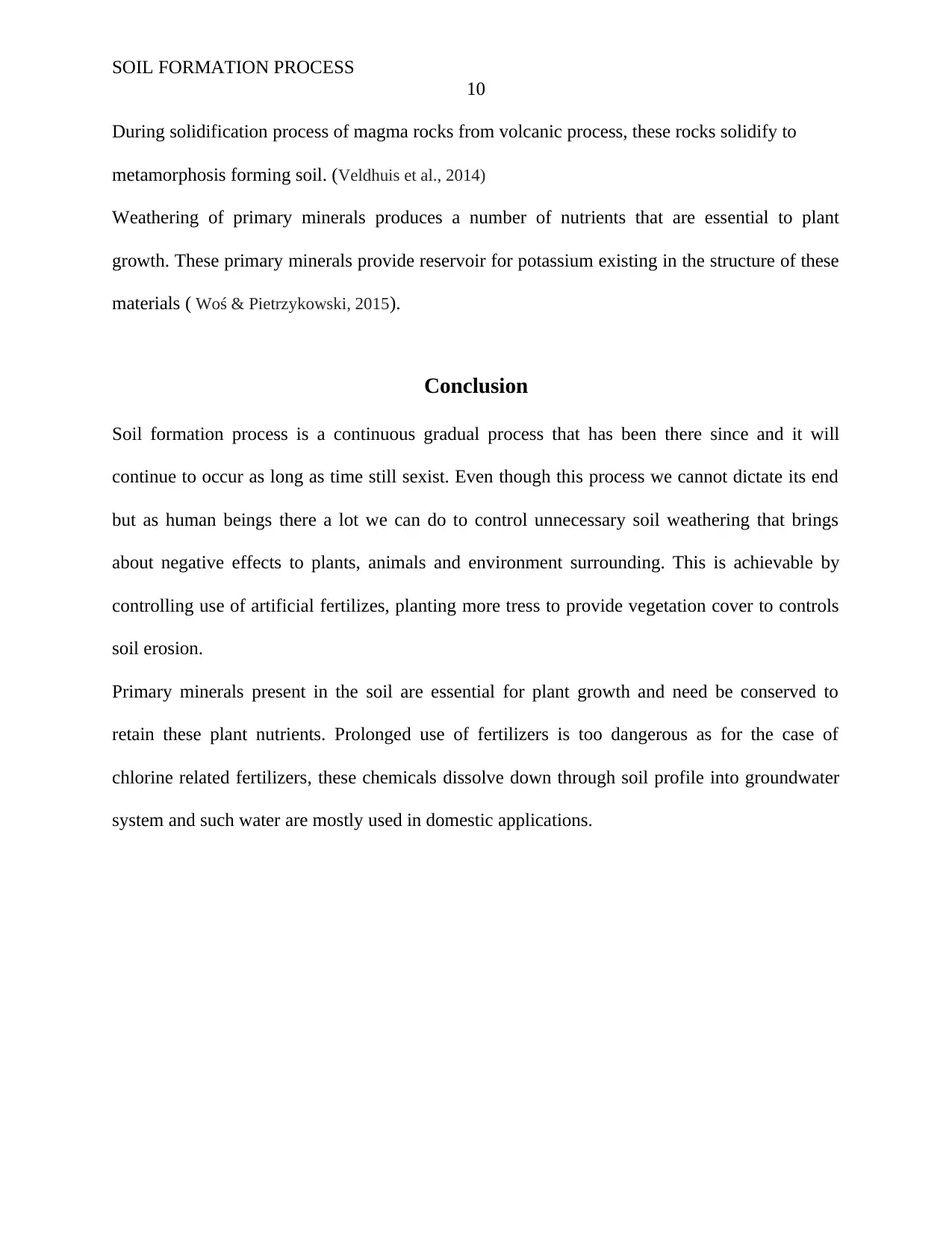
SOIL FORMATION PROCESS
10
During solidification process of magma rocks from volcanic process, these rocks solidify to
metamorphosis forming soil. (Veldhuis et al., 2014)
Weathering of primary minerals produces a number of nutrients that are essential to plant
growth. These primary minerals provide reservoir for potassium existing in the structure of these
materials ( Woś & Pietrzykowski, 2015).
Conclusion
Soil formation process is a continuous gradual process that has been there since and it will
continue to occur as long as time still sexist. Even though this process we cannot dictate its end
but as human beings there a lot we can do to control unnecessary soil weathering that brings
about negative effects to plants, animals and environment surrounding. This is achievable by
controlling use of artificial fertilizes, planting more tress to provide vegetation cover to controls
soil erosion.
Primary minerals present in the soil are essential for plant growth and need be conserved to
retain these plant nutrients. Prolonged use of fertilizers is too dangerous as for the case of
chlorine related fertilizers, these chemicals dissolve down through soil profile into groundwater
system and such water are mostly used in domestic applications.
10
During solidification process of magma rocks from volcanic process, these rocks solidify to
metamorphosis forming soil. (Veldhuis et al., 2014)
Weathering of primary minerals produces a number of nutrients that are essential to plant
growth. These primary minerals provide reservoir for potassium existing in the structure of these
materials ( Woś & Pietrzykowski, 2015).
Conclusion
Soil formation process is a continuous gradual process that has been there since and it will
continue to occur as long as time still sexist. Even though this process we cannot dictate its end
but as human beings there a lot we can do to control unnecessary soil weathering that brings
about negative effects to plants, animals and environment surrounding. This is achievable by
controlling use of artificial fertilizes, planting more tress to provide vegetation cover to controls
soil erosion.
Primary minerals present in the soil are essential for plant growth and need be conserved to
retain these plant nutrients. Prolonged use of fertilizers is too dangerous as for the case of
chlorine related fertilizers, these chemicals dissolve down through soil profile into groundwater
system and such water are mostly used in domestic applications.
Paraphrase This Document
Need a fresh take? Get an instant paraphrase of this document with our AI Paraphraser
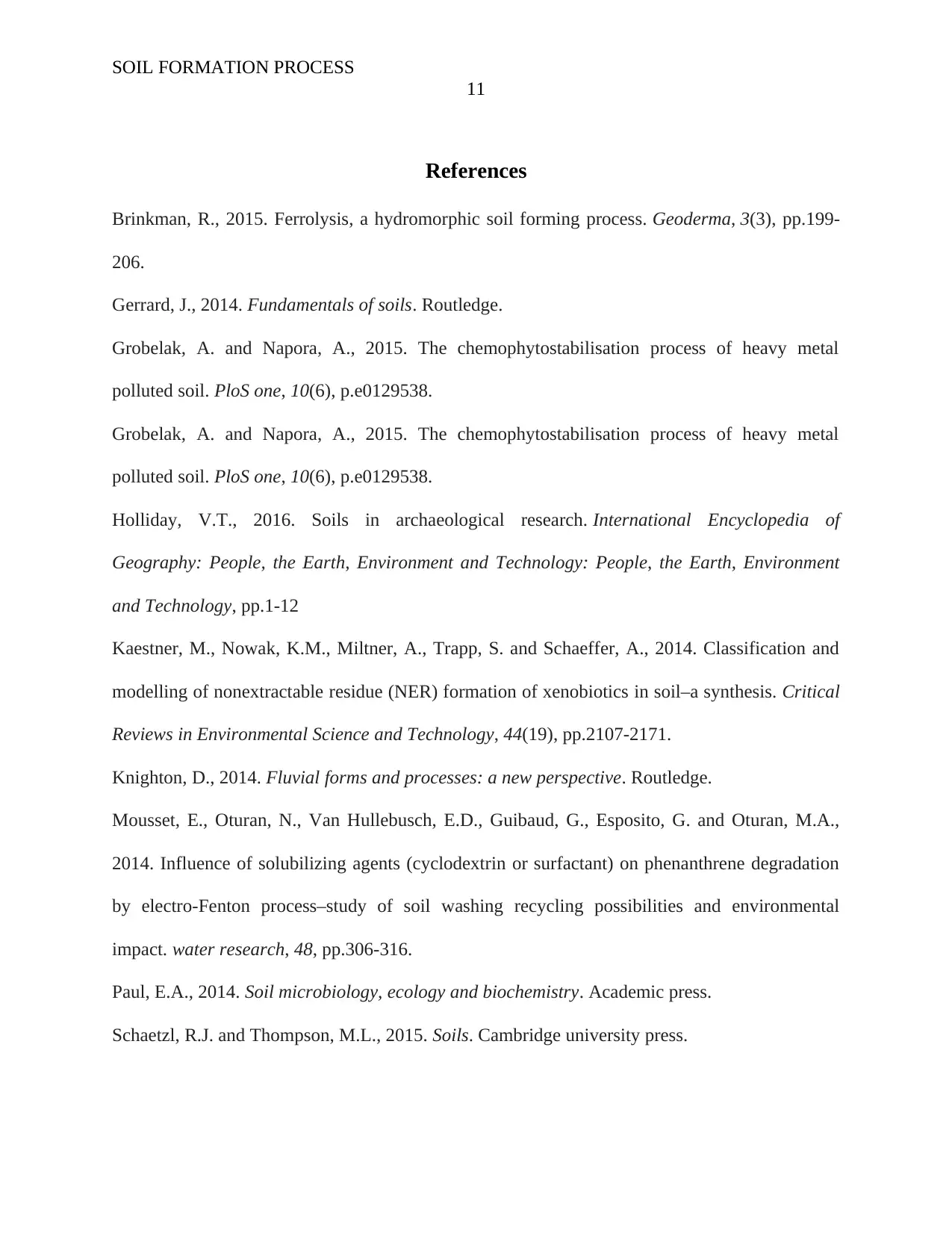
SOIL FORMATION PROCESS
11
References
Brinkman, R., 2015. Ferrolysis, a hydromorphic soil forming process. Geoderma, 3(3), pp.199-
206.
Gerrard, J., 2014. Fundamentals of soils. Routledge.
Grobelak, A. and Napora, A., 2015. The chemophytostabilisation process of heavy metal
polluted soil. PloS one, 10(6), p.e0129538.
Grobelak, A. and Napora, A., 2015. The chemophytostabilisation process of heavy metal
polluted soil. PloS one, 10(6), p.e0129538.
Holliday, V.T., 2016. Soils in archaeological research. International Encyclopedia of
Geography: People, the Earth, Environment and Technology: People, the Earth, Environment
and Technology, pp.1-12
Kaestner, M., Nowak, K.M., Miltner, A., Trapp, S. and Schaeffer, A., 2014. Classification and
modelling of nonextractable residue (NER) formation of xenobiotics in soil–a synthesis. Critical
Reviews in Environmental Science and Technology, 44(19), pp.2107-2171.
Knighton, D., 2014. Fluvial forms and processes: a new perspective. Routledge.
Mousset, E., Oturan, N., Van Hullebusch, E.D., Guibaud, G., Esposito, G. and Oturan, M.A.,
2014. Influence of solubilizing agents (cyclodextrin or surfactant) on phenanthrene degradation
by electro-Fenton process–study of soil washing recycling possibilities and environmental
impact. water research, 48, pp.306-316.
Paul, E.A., 2014. Soil microbiology, ecology and biochemistry. Academic press.
Schaetzl, R.J. and Thompson, M.L., 2015. Soils. Cambridge university press.
11
References
Brinkman, R., 2015. Ferrolysis, a hydromorphic soil forming process. Geoderma, 3(3), pp.199-
206.
Gerrard, J., 2014. Fundamentals of soils. Routledge.
Grobelak, A. and Napora, A., 2015. The chemophytostabilisation process of heavy metal
polluted soil. PloS one, 10(6), p.e0129538.
Grobelak, A. and Napora, A., 2015. The chemophytostabilisation process of heavy metal
polluted soil. PloS one, 10(6), p.e0129538.
Holliday, V.T., 2016. Soils in archaeological research. International Encyclopedia of
Geography: People, the Earth, Environment and Technology: People, the Earth, Environment
and Technology, pp.1-12
Kaestner, M., Nowak, K.M., Miltner, A., Trapp, S. and Schaeffer, A., 2014. Classification and
modelling of nonextractable residue (NER) formation of xenobiotics in soil–a synthesis. Critical
Reviews in Environmental Science and Technology, 44(19), pp.2107-2171.
Knighton, D., 2014. Fluvial forms and processes: a new perspective. Routledge.
Mousset, E., Oturan, N., Van Hullebusch, E.D., Guibaud, G., Esposito, G. and Oturan, M.A.,
2014. Influence of solubilizing agents (cyclodextrin or surfactant) on phenanthrene degradation
by electro-Fenton process–study of soil washing recycling possibilities and environmental
impact. water research, 48, pp.306-316.
Paul, E.A., 2014. Soil microbiology, ecology and biochemistry. Academic press.
Schaetzl, R.J. and Thompson, M.L., 2015. Soils. Cambridge university press.
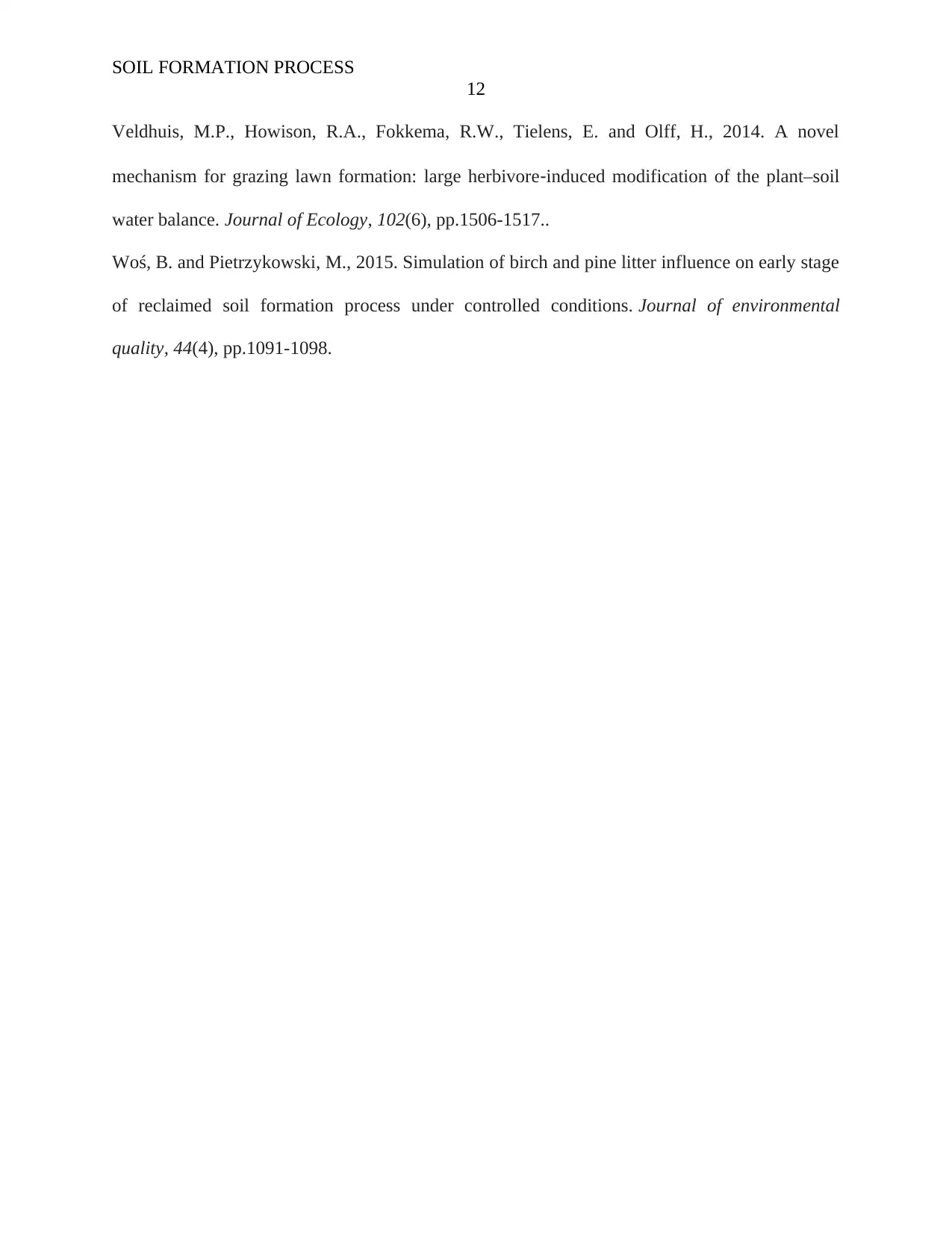
SOIL FORMATION PROCESS
12
Veldhuis, M.P., Howison, R.A., Fokkema, R.W., Tielens, E. and Olff, H., 2014. A novel
mechanism for grazing lawn formation: large herbivore‐induced modification of the plant–soil
water balance. Journal of Ecology, 102(6), pp.1506-1517..
Woś, B. and Pietrzykowski, M., 2015. Simulation of birch and pine litter influence on early stage
of reclaimed soil formation process under controlled conditions. Journal of environmental
quality, 44(4), pp.1091-1098.
12
Veldhuis, M.P., Howison, R.A., Fokkema, R.W., Tielens, E. and Olff, H., 2014. A novel
mechanism for grazing lawn formation: large herbivore‐induced modification of the plant–soil
water balance. Journal of Ecology, 102(6), pp.1506-1517..
Woś, B. and Pietrzykowski, M., 2015. Simulation of birch and pine litter influence on early stage
of reclaimed soil formation process under controlled conditions. Journal of environmental
quality, 44(4), pp.1091-1098.
⊘ This is a preview!⊘
Do you want full access?
Subscribe today to unlock all pages.

Trusted by 1+ million students worldwide
1 out of 12
Related Documents
Your All-in-One AI-Powered Toolkit for Academic Success.
+13062052269
info@desklib.com
Available 24*7 on WhatsApp / Email
![[object Object]](/_next/static/media/star-bottom.7253800d.svg)
Unlock your academic potential
Copyright © 2020–2025 A2Z Services. All Rights Reserved. Developed and managed by ZUCOL.





